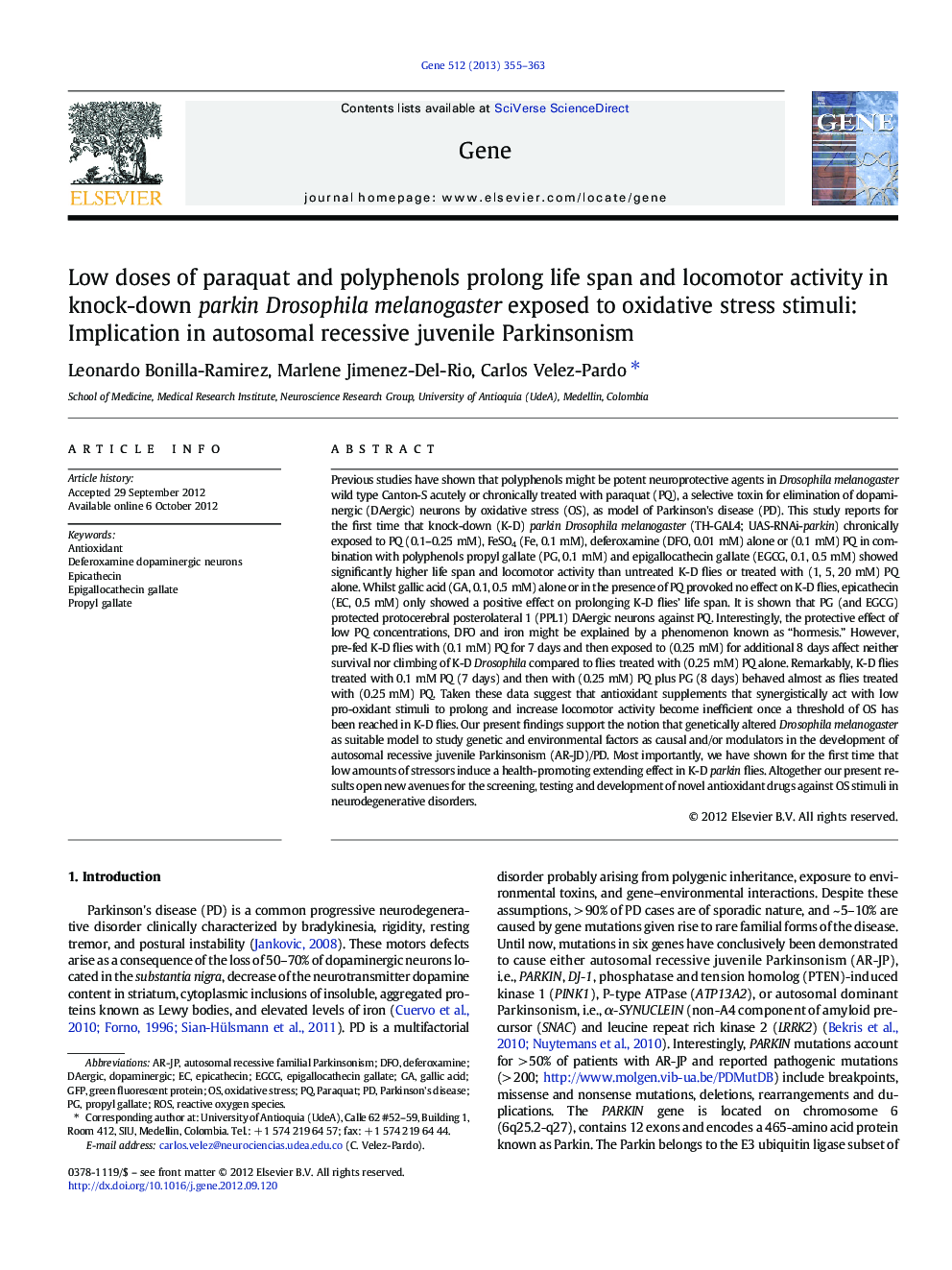| کد مقاله | کد نشریه | سال انتشار | مقاله انگلیسی | نسخه تمام متن |
|---|---|---|---|---|
| 2817457 | 1159989 | 2013 | 9 صفحه PDF | دانلود رایگان |

Previous studies have shown that polyphenols might be potent neuroprotective agents in Drosophila melanogaster wild type Canton-S acutely or chronically treated with paraquat (PQ), a selective toxin for elimination of dopaminergic (DAergic) neurons by oxidative stress (OS), as model of Parkinson's disease (PD). This study reports for the first time that knock-down (K-D) parkin Drosophila melanogaster (TH-GAL4; UAS-RNAi-parkin) chronically exposed to PQ (0.1–0.25 mM), FeSO4 (Fe, 0.1 mM), deferoxamine (DFO, 0.01 mM) alone or (0.1 mM) PQ in combination with polyphenols propyl gallate (PG, 0.1 mM) and epigallocathecin gallate (EGCG, 0.1, 0.5 mM) showed significantly higher life span and locomotor activity than untreated K-D flies or treated with (1, 5, 20 mM) PQ alone. Whilst gallic acid (GA, 0.1, 0.5 mM) alone or in the presence of PQ provoked no effect on K-D flies, epicathecin (EC, 0.5 mM) only showed a positive effect on prolonging K-D flies’ life span. It is shown that PG (and EGCG) protected protocerebral posterolateral 1 (PPL1) DAergic neurons against PQ. Interestingly, the protective effect of low PQ concentrations, DFO and iron might be explained by a phenomenon known as “hormesis.” However, pre-fed K-D flies with (0.1 mM) PQ for 7 days and then exposed to (0.25 mM) for additional 8 days affect neither survival nor climbing of K-D Drosophila compared to flies treated with (0.25 mM) PQ alone. Remarkably, K-D flies treated with 0.1 mM PQ (7 days) and then with (0.25 mM) PQ plus PG (8 days) behaved almost as flies treated with (0.25 mM) PQ. Taken these data suggest that antioxidant supplements that synergistically act with low pro-oxidant stimuli to prolong and increase locomotor activity become inefficient once a threshold of OS has been reached in K-D flies. Our present findings support the notion that genetically altered Drosophila melanogaster as suitable model to study genetic and environmental factors as causal and/or modulators in the development of autosomal recessive juvenile Parkinsonism (AR-JD)/PD. Most importantly, we have shown for the first time that low amounts of stressors induce a health-promoting extending effect in K-D parkin flies. Altogether our present results open new avenues for the screening, testing and development of novel antioxidant drugs against OS stimuli in neurodegenerative disorders.
► Low doses of paraquat prolong life span/locomotor activity in knock-down parkin fly.
► Iron and deferoxamine prolong survival/climbing activity in knock-down parkin fly.
► Some polyphenols act synergistically with low doses of paraquat in knock-down fly.
► Genetically altered fly as suitable model to study genetic and environmental factor.
Journal: Gene - Volume 512, Issue 2, 10 January 2013, Pages 355–363